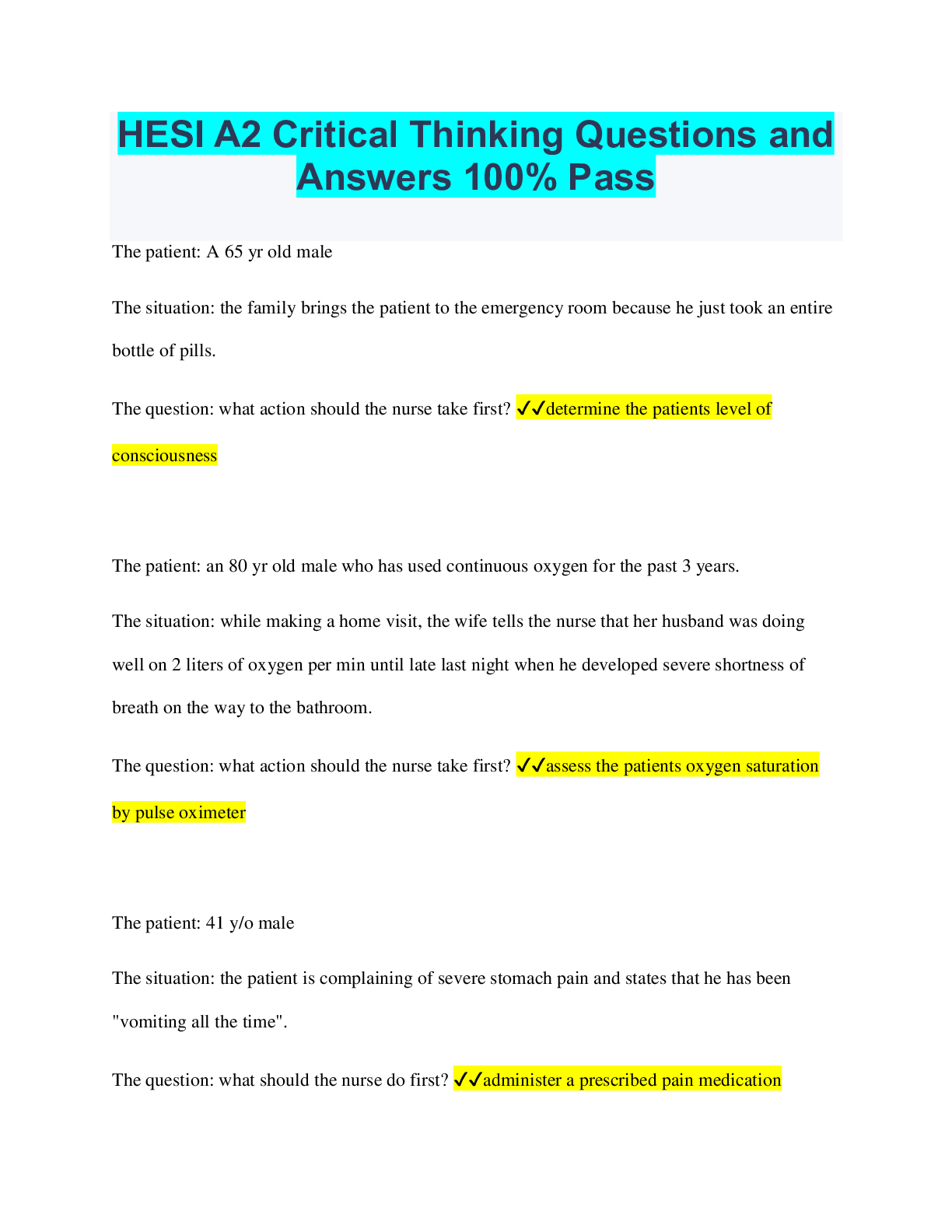Biology > QUESTIONS & ANSWERS > LAB VALUES Normal laboratory values & significance (All)
LAB VALUES Normal laboratory values & significance
Document Content and Description Below
LAB VALUES Normal laboratory values & significance TEST SIGNIFICANCE Hemoglobin Measures oxygen carrying capacity of blood N.R. = 12-18 g/100mL Hemoglobin Low: >hemorrhage >anemia High: >poly... cythemia Hematocrit Measures relative volume of cells and plasma in blood N.R.= 35%-50% Hematocrit Low: >hemorrhage >anemia High: >polycythemia >dehydration Red Blood Cell Measures oxygencarrying capacity of blood N.R.= 4-6 million/mm3 Red Blood Cell Low: >hemorrhage >anemia High: >polycythemia >heart disease >pulmonary disease White Blood Cell Measures host defense against inflammatory agents Infant N.R.= White Blood Cell Low: >aplastic anemia >drug toxicity >specific infections High: >inflammation >trauma toxicity >leukemia 8,000-15,000/mm3 4-7 yrs. old N.R.= 6,000-15,000/mm3 8-18 yrs. old N.R.= 4,500-13,500/mm3 Neutrophils White blood cells that fight bacterial infection. N.R.= 54%-62% Neutrophils will increase in >bacterial infections >hemorrhage >diabetic acidosis Lymphocytes Large granular are more commonly known as the natural killer cells. Small ones are the T cells and B cells. N.R.= 25%- 30% >Viral and bacterial infection >acute & chronic lymphocytic leukemia >antigen reaction Eosinophils A WBC found in vertebrate blood, containing cytoplasmic granules that are easily stained by eosin or other acid dyes. N.R.= 1%-3% Eosinophils will increase in >parasitic & allergic conditions >blood dyscrasias >pernicious anemia Basophils A cell, especially a white blood cell, having granules that stain readily with basic dyes. N.R.= 1% Basophils will increase in >types of blood dyscrasias Monocytes A large, circulating, phagocytic WBC, having a single well-defined nucleus and very fine granulation in the cytoplasm. They constitute from 3 to 8 percent of the white blood cells in humans. N.R.= 0 - 9% Monocytes is linked to >Hodgkin’s disease >lipid storage disease >recovery from severe infections >monocytic leukemia Prothrombin Time Measures extrinsic clotting factors N.R.= 11-16 sec Prothrombin Time will be >prolonged in liver disease >impaired Vitamin K production >surgical trauma with blood loss Partial Thromboplastin Time Measures intrinsic clotting of Partial Thromboplstin time is >prolonged in hemophilia A,B, & C, >Von Willebrand’s disease blood, congenital clotting disorders N.R.= 60-70 seconds Platelets Measures clotting potential N.R.= 140,000- 340,000/mL Platelets is increased in >polycythemia >leukemia >severe hemorrhage decreased in >thrombocytopenia purpura Bleeding Time Measures quality of platelets N.R.= 1-6 min Bleeding time will be >prolonged in thrombocytopenia International Normalized Ratio (INR) Measures extrinsic clotting function N.R. Without anticoagulant therapy : 1 Anticoagulant therapy target range: 2-3 Internation Normalized Ratio will be >increased with anticoagulant therapy Urinalysis - Volume N.R. = 1,000-2,000 mL/d Urinalysis will be >increased in diabetes mellitus >chronic nephritis Urinalysis - Specific gravity Measures the degree of tubular reabsorption and dehydration N.R. = 1.015-1.025 U/A specific gravity will be Increased in >diabetes mellitus Decreased in >acute nephritis >diabetes insipidus >aldosteronism Urinalysis - pH Reflects acidosis and alkalosis N.R. = 6-8 U/A pH Acidic in >diabetes >acidosis >prolonged fever Alkalinic in >urinary tract infection >alkalosis Urinalysis - Casts N.R. = 1-2 per high power field U/A Casts will yield >renal tubule degeneration occuring in cardiac failure,pregnancy,hemoglobinuricnephrosis Electrolytes - Sodium (Na) Reflects acid-base balance N.R. = 135- 145 mEq Electrolytes - Sodium (Na) will be >increased in Cushing’s syndrome Electrolytes - Potassium (K) N.R. = 3.5-5 mEq Electrolytes - Potassium (K) will be >increased in tissue breakdown Electrolytes - Bicarbonate (HCO3) Ingestion of bicarbonate is a (blank) common remedy for ‘indigestion’, because it neutralizes stomach acid. N.R. = 24-30 mEq Electrolytes - Chloride (Cl) N.R. = 100-106 mEq Electrolyte - Chloride (Cl) will be >increased in renal disease >hypertension [Show More]
Last updated: 2 years ago
Preview 1 out of 6 pages

Buy this document to get the full access instantly
Instant Download Access after purchase
Buy NowInstant download
We Accept:

Reviews( 0 )
$8.00
Can't find what you want? Try our AI powered Search
Document information
Connected school, study & course
About the document
Uploaded On
Jan 20, 2023
Number of pages
6
Written in
Additional information
This document has been written for:
Uploaded
Jan 20, 2023
Downloads
0
Views
106














